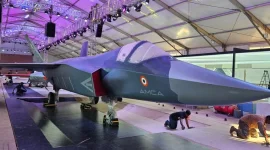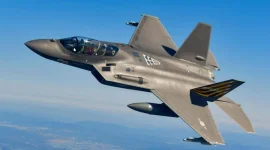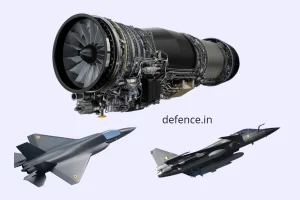- Views: 2K
- Replies: 9
A recent agreement between the United Arab Emirates (UAE) and South Korea regarding the KF-21 Boramae fighter jet highlights a crucial lesson for India's own advanced aircraft program: securing international collaboration early is essential for export success in the competitive global defence market.
On April 16, 2025, the UAE Air Force and Air Defence (AFAD) signed a letter of intent with the Republic of Korea Air Force (RoKAF) aimed at comprehensive cooperation on the South Korean 4.5-generation jet.
This move signals significant UAE interest, potentially leading to future acquisition, even as the nation proceeds with acquiring 80 Rafale F4 jets from France.
The UAE's engagement with South Korea's KF-21, developed by Korea Aerospace Industries (KAI), along with its reported consideration of Turkey's TF Kaan fighter, points to a wider strategy among Gulf nations.
These countries are increasingly looking beyond traditional Western suppliers to diversify their defence capabilities by partnering with emerging aerospace nations.
This trend presents both a challenge and an opportunity for India as it develops its 5.5-generation Advanced Medium Combat Aircraft (AMCA), underscoring the need to actively seek global partners to ensure the program's financial viability and international reach.
The KF-21 Boramae is a twin-engine multirole fighter designed as a modern replacement for South Korea's older F-4E Phantom II aircraft, offering capabilities between fourth and fifth-generation standards.
It features ten external hardpoints for weapons, supports NATO-standard munitions like the Meteor air-to-air missile, and includes a new South Korean short-range missile.
Aimed at nations seeking advanced but affordable fighters, serial production commenced in July 2024, with first deliveries to the RoKAF anticipated by late 2026.
Formalised during a ceremony in South Korea where a senior UAE military official flew in the aircraft, the letter of intent allows UAE personnel to observe KF-21 exercises and understand its operational systems.
This step builds on earlier interest expressed by the UAE's Tawazun Economic Council in 2023 and comes at a time when Indonesia, an initial partner in the KF-21 project, has faced difficulties meeting its financial commitments. The UAE's actions reflect a strategic shift towards broadening its defence procurement sources.
This pattern extends across the region, with Saudi Arabia also reportedly exploring both the KF-21 and Turkey's TF Kaan. This interest from major Middle Eastern powers in non-Western alternatives like the South Korean and Turkish jets demonstrates a desire to reduce reliance on traditional suppliers and navigate complex geopolitical landscapes.
These examples show how proactive international engagement by countries like South Korea and Turkey can significantly boost their defence programs.
India's AMCA, led by the Defence Research and Development Organisation (DRDO) and Hindustan Aeronautics Limited (HAL), represents a significant leap, aiming for 5.5-generation capabilities.
Envisioned to replace the Indian Air Force's Mirage 2000 and Jaguar fleets from the mid-2030s, the AMCA incorporates advanced features like stealth design, internal weapons carriage, sophisticated avionics, and supercruise (sustained supersonic flight without afterburners).
Approved for prototype development in September 2024 with an estimated initial budget of Rs 15,000 crore, the first flight is projected for 2029, targeting induction around 2035.
While the AMCA targets high-end capabilities, positioning it against top-tier aircraft like the F-35, its current domestic focus contrasts sharply with the export-oriented strategies seen with the KF-21 and Kaan.
Without securing early international partnerships, India risks limiting the AMCA's export potential in a global market where competitors are already actively engaging potential buyers.
The Case for Early AMCA Partnerships
The UAE-South Korea KF-21 agreement provides compelling reasons for India to pursue international partners for the AMCA program urgently:- Financial Burden Sharing: Developing advanced fighter jets involves immense costs. The AMCA's research and development represent a significant investment within India's defence budget (Rs 6.21 lakh crore for 2024-25). Partnerships, like Indonesia's initial cost-sharing in the KF-21, can distribute this financial load. Investment from partners could also fund future upgrades for the AMCA, incorporating advanced indigenous systems.
- Building Market Confidence: Securing partners early demonstrates international confidence in the aircraft and helps lock in future export orders. South Korea and Turkey are already courting Middle Eastern nations known for substantial defence spending. India needs to engage potential buyers in regions like the Middle East and Southeast Asia promptly to avoid losing ground.
- Strengthening Strategic Ties: Collaborating with nations in the Gulf or Southeast Asia on a major defence project like the AMCA can enhance India's geopolitical standing and provide alternatives to nations seeking diversified defence suppliers, potentially countering the influence of competitors like China.
- Integrating Supply Chains: Early partners can involve their own industries in manufacturing components for the AMCA, similar to arrangements seen in the KF-21 program. This integration fosters commitment from partner nations and strengthens India's domestic defence manufacturing base, benefiting private sector companies.
- Staying Competitive: With China actively marketing its fighters and both the KF-21 and Kaan progressing rapidly (already flying or in production), India must act decisively to position the AMCA as a credible option in the international market.
Furthermore, overcoming concerns related to potential production delays, based on past experiences with other platforms, will require demonstrable project management efficiency.
The AMCA's advanced features also mean higher costs, potentially limiting its appeal in markets favouring more affordable options.
To navigate these hurdles, India could prioritise outreach to nations with existing defence relationships, potentially offering co-development roles, technology sharing, or attractive industrial participation agreements.
Proactive marketing at major international air shows and defence exhibitions will also be crucial to showcase the AMCA's potential and engage prospective international partners effectively.



